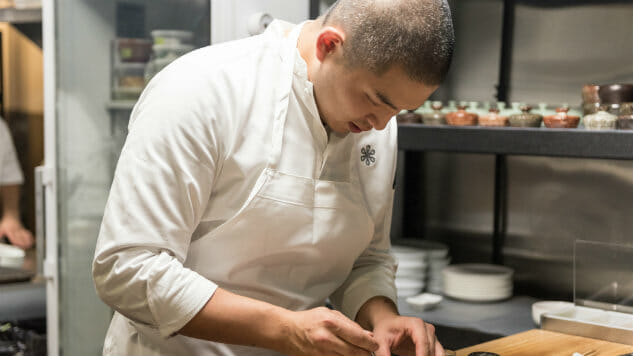San Francisco’s MOSU, an 18-seat restaurant that opened this February, is based on the premise that low decibel levels are good for food—both eating and preparing it. The restaurant sits about a hundred feet from the wildly popular (and noisy) State Bird Provisions, behind an unmarked door on Fillmore Street. There are no white tablecloths and the service isn’t stuffy, but near-silence awaits diners inside.
This is hardly an oversight. MOSU’s Chef Sung Anh made the deliberate decision — an almost philosophical one — to forgo music and maintain quiet reverence for the food. This applies not only to the minimalist dining room, which was designed by Anh, but also to the kitchen, where pin-drop conditions prevail. “In the beginning, some were saying it was kind of weird not having any music,” says Anh, “but when we have music playing, our focus in the kitchen is scattered.”
After spending a few days immersed in quiet, a couple of staff members decided to move on, Anh told me. But the rest have embraced the special surroundings at MOSU. “It’s not for everyone,” Anh explains, “but for some, it is an interesting and calming environment. They have understood exactly what I wanted to do.”
It shouldn’t come as a surprise that restaurants are louder than ever. But do noise levels affect the flavors of food? Probably. One study found that loud noise while dining compromises taste and changes the experience of eating (in this case, enhancing umami savoriness and suppressing sweetness). If a raucous restaurant impairs your ability to taste food and drink normally, cultural sensibilities have only added to the problem: the louder the restaurant, the more packed and frenetic the feel, the better the food is assumed to be. The modern-day industrial aesthetic of open kitchens, polished metal and wood surfaces, concrete floors, and bare walls, meanwhile, has done nothing to calm the acoustics of dining.
“The Great Noise Boom; as New York Magazine’s Adam Platt characterized it, has its share of detractors. Michael Bauer of the San Francisco Chronicle, an early crusader against restaurant clamor, introduced decibel level ratings in his reviews over a decade ago. In Spain, there is an “Eating Without Noise; movement, a grassroots initiative to lower the volume at eating establishments that have a reputation for being some of the liveliest (and loudest) in the world. OpenTable now lets users rate restaurants as “quiet,” “moderate,” or “energetic” — the site’s euphemism for “deafening din.” An earsplitting environment has become more than just an intergenerational bone of contention. Glance at the comments sections of a few restaurant reviews and you’ll see evidence of a deep desire for food that is buzzworthy, but that doesn’t require drowning in noise.
Anh emphasized from the beginning of constructing MOSU that a quiet restaurant was his priority. He cites his training at Urasawa, the famed sushi restaurant in Beverly Hills, as a formative influence that taught him to appreciate the virtues of silence. He traded his traditional Japanese robes for a white chef’s coat, working in high-end Bay Area kitchens: The French Laundry, Benu, and Aziza, where he was chef de cuisine. But with his own endeavor, a dream he chased for many years, Anh sought to channel the hushed elegance of a Japanese restaurant. “It’s that Zen-ness I’m after. When everyone in the kitchen is working quietly, there’s a sense of peace,” Anh insists. “I can sense that things are working harmoniously. I feel the focus, the passion, the energy that means the food is going to be good.”
Chef Anh’s food is as warm, calming and Zen as his acoustics. Anh, born in Seoul and raised working in his parents’ Chinese restaurant, describes his flavors as American with heavy Asian influences. At MOSU, he often draws on elements of his childhood in Korea — for example, short rib with pear, lily and goji berries, or seaweed soup with foie gras, the coda to MOSU’s tasting menu. Seaweed soup is said to have restorative powers, favored by women in the days and weeks following childbirth. “Traditionally in Korea, you eat seaweed soup on your birthday,” says Anh, explaining the dish’s cultural significance. “It’s something special and hard to get here. I wanted to end the meal with a celebration.”
Anh’s emphasis on quiet is admirable, but will his endeavor succeed? A flurry of studies continues to tout the benefits of quiet calm for the brain and the rest of the body. But focusing on just one task — in this case, enjoying a special occasion meal — runs counter to cultural norms. Diners are accustomed to texting, shouting, and Instagramming, all while taking in bites of food. The absence of noise, especially at a restaurant, a public place of consumption and enjoyment, can seem jarring — or at least disorienting — to some.
Anh’s silence is a radical move. “I’m trying to generate something different, for the sake of experience,” he told me. “I’m challenging the guests and myself at the restaurant by creating a different environment.”
